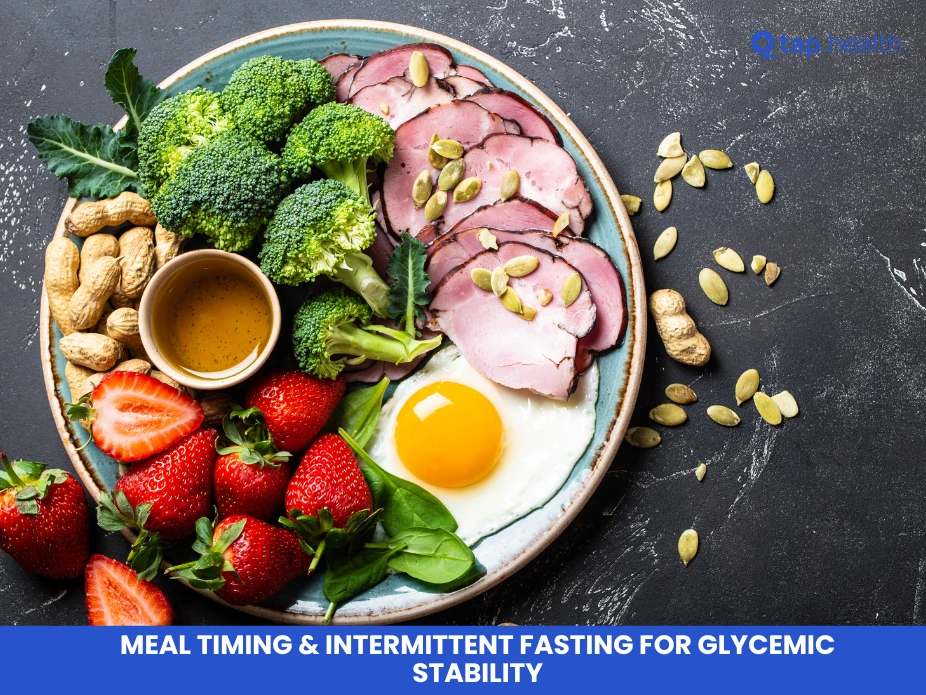Glycemic stability is critical for maintaining healthy blood sugar levels, preventing insulin resistance, and managing diabetes. While much attention is given to what we eat, the timing of meals and strategies like intermittent fasting (IF) play a significant role in glycemic control. This article dives deep into how meal timing and intermittent fasting contribute to better glycemic stability, supported by research, real-life examples, and expert opinions.
Understanding Glycemic Stability
Glycemic stability refers to the consistent regulation of blood sugar levels within a healthy range. Fluctuations in blood sugar can lead to energy crashes, mood swings, and long-term health risks such as diabetes and cardiovascular issues.
Factors Influencing Glycemic Stability
- Meal composition: Carbohydrates, fats, and proteins affect blood sugar differently.
- Meal timing: The intervals between meals and the time of day impact insulin sensitivity.
- Activity levels: Exercise can significantly enhance glycemic control.
- Hormonal rhythms: Circadian rhythms influence how our bodies metabolize food.
What is Meal Timing?
Meal timing involves structuring the times at which you eat throughout the day. The idea is to align eating habits with your body’s natural rhythms to optimize metabolic processes.
Benefits of Meal Timing
- Enhanced insulin sensitivity: Consistent meal patterns improve how cells respond to insulin.
- Reduced blood sugar spikes: Timely meals help prevent sharp rises in glucose.
- Improved metabolic efficiency: Eating at regular intervals aligns with circadian rhythms.
Examples of Effective Meal Timing
- Eating a protein-rich breakfast within an hour of waking.
- Avoiding late-night meals to reduce insulin resistance.
- Having balanced meals spaced 4–6 hours apart.
What is Intermittent Fasting?
Intermittent fasting (IF) is an eating pattern that alternates between periods of eating and fasting. It focuses on when you eat rather than what you eat.
Popular IF Methods
- 16/8 Method: 16 hours of fasting with an 8-hour eating window.
- 5:2 Diet: Five days of normal eating and two days of reduced calorie intake.
- Alternate-Day Fasting: Fasting every other day or eating very few calories on fasting days.
How Meal Timing and Intermittent Fasting Improve Glycemic Stability
1. Insulin Sensitivity
Fasting and well-timed meals reduce insulin levels and enhance the body’s ability to use glucose effectively. Research shows that fasting lowers fasting glucose and insulin levels, improving overall metabolic health.
2. Stabilized Blood Sugar Levels
Eating during periods of higher insulin sensitivity (e.g., earlier in the day) and fasting overnight can prevent glucose spikes and crashes.
3. Reduced Risk of Insulin Resistance
By allowing the body periods of rest from continuous digestion, fasting decreases the risk of insulin resistance, a precursor to Type 2 diabetes.
4. Weight Management
Both meal timing and fasting support weight loss or maintenance, which directly impacts glycemic control.
Scientific Evidence Supporting Meal Timing and Fasting
Meal Timing Studies
- A 2017 study in Diabetes Care found that eating larger breakfasts and smaller dinners improved blood sugar levels and reduced insulin resistance in Type 2 diabetics.
- Research in The Journal of Clinical Endocrinology & Metabolism highlights that early time-restricted eating (eating all meals before 6 PM) significantly improves glucose tolerance.
Intermittent Fasting Studies
- A 2019 review in Nutrients concluded that intermittent fasting improves fasting blood glucose, insulin sensitivity, and HbA1c levels in individuals with prediabetes and Type 2 diabetes.
- A study in Cell Metabolism (2020) found that fasting reduced glucose levels and increased fat oxidation, further stabilizing glycemic levels.
Real-Life Scenarios
Scenario 1: The Early Bird
Anna, a 40-year-old with prediabetes, adopts early time-restricted feeding (eating from 7 AM to 3 PM). Over three months, her fasting glucose drops by 10%, and she reports improved energy levels.
Scenario 2: The Busy Professional
James, a 35-year-old with Type 2 diabetes, switches to the 16/8 fasting method, eating from noon to 8 PM. His post-meal blood sugar levels stabilize, and he loses 5 pounds in two months.
Scenario 3: Night Owl Adjustments
Martha, a shift worker with insulin resistance, times her meals to avoid eating during her night shifts. This simple change lowers her glucose variability and improves sleep quality.
Expert Contributions
Nutritionists’ Views
Registered Dietitian Emily Carter says, “Meal timing is a game-changer for glycemic stability. Starting the day with a balanced breakfast and avoiding late-night snacking align with the body’s metabolic peaks.”
Endocrinologists’ Insights
Dr. Raj Patel explains, “Intermittent fasting reduces the constant insulin spikes caused by frequent meals, providing the pancreas much-needed rest and improving long-term glucose control.”
Researchers’ Perspective
Dr. Helen Wright, a metabolic health researcher, adds, “Circadian biology shows that eating during daylight hours optimizes glucose metabolism. Combining fasting with this principle amplifies its benefits.”
Recommendations Grounded in Proven Research and Facts
Meal Timing Tips
- Front-load Calories: Consume larger meals earlier in the day when insulin sensitivity is highest.
- Avoid Late-Night Eating: Stop eating at least 3 hours before bed.
- Stay Consistent: Maintain regular meal times to train your body for stable glucose handling.
Intermittent Fasting Tips
- Start Slow: Begin with a 12-hour fast and gradually increase fasting windows.
- Hydrate Well: Drink water, herbal teas, or black coffee during fasting periods.
- Choose Balanced Meals: When breaking a fast, prioritize proteins, healthy fats, and fiber to avoid blood sugar spikes.
Factual and Reliable Information
The benefits of meal timing and intermittent fasting are backed by scientific research and real-world results. From improving insulin sensitivity to reducing HbA1c levels, these strategies offer significant advantages in glycemic control.
Study References
- Jakubowicz, D., et al. (2017). “Higher calorie breakfast improves glycemic control in Type 2 diabetes.” Diabetes Care. Read here
- Patterson, R. E., et al. (2019). “Intermittent fasting and human metabolic health.” Nutrients. Read here
Is TapHealth the Right Name for Diabetes Management with Meal Timing and Fasting?
TapHealth empowers people with diabetes to take charge of their blood sugar through smart meal timing and mindful fasting guidance. By helping align eating patterns with your circadian rhythm, TapHealth supports improved insulin sensitivity, reduced glucose fluctuations, and better metabolic health.
With scientifically designed recommendations, TapHealth encourages gradual adoption of structured eating windows and personalized schedules so you can build sustainable habits—not quick fixes. Real-time monitoring, reminders, and progress tracking ensure you stay on the right path every day.
FAQs on Meal Timing & Intermittent Fasting for Glycemic Stability
1. Is intermittent fasting safe for diabetics?
Yes, but it should be done under medical supervision, especially if you’re on medications that affect blood sugar levels.
2. How long does it take to see results from meal timing changes?
Most people notice improved energy and glucose levels within a few weeks, but significant HbA1c improvements may take 3–6 months.
3. Can I combine meal timing with intermittent fasting?
Absolutely! Aligning your fasting and eating windows with your circadian rhythms enhances glycemic stability.
4. Does fasting mean skipping meals?
Not necessarily. It’s about consolidating your eating into specific time windows rather than reducing total calories.
5. Are there risks with fasting?
Fasting can cause low blood sugar (hypoglycemia) if not done carefully, especially for those taking insulin or sulfonylureas.
Conclusion
Meal timing and intermittent fasting are powerful tools for achieving better glycemic stability. By focusing on when you eat, you can optimize your body’s natural insulin sensitivity, reduce glucose variability, and improve overall metabolic health. These strategies are not one-size-fits-all, so finding a routine that fits your lifestyle and consulting with healthcare professionals is crucial.
Take charge of your blood sugar today with these science-backed approaches to meal timing and fasting!



